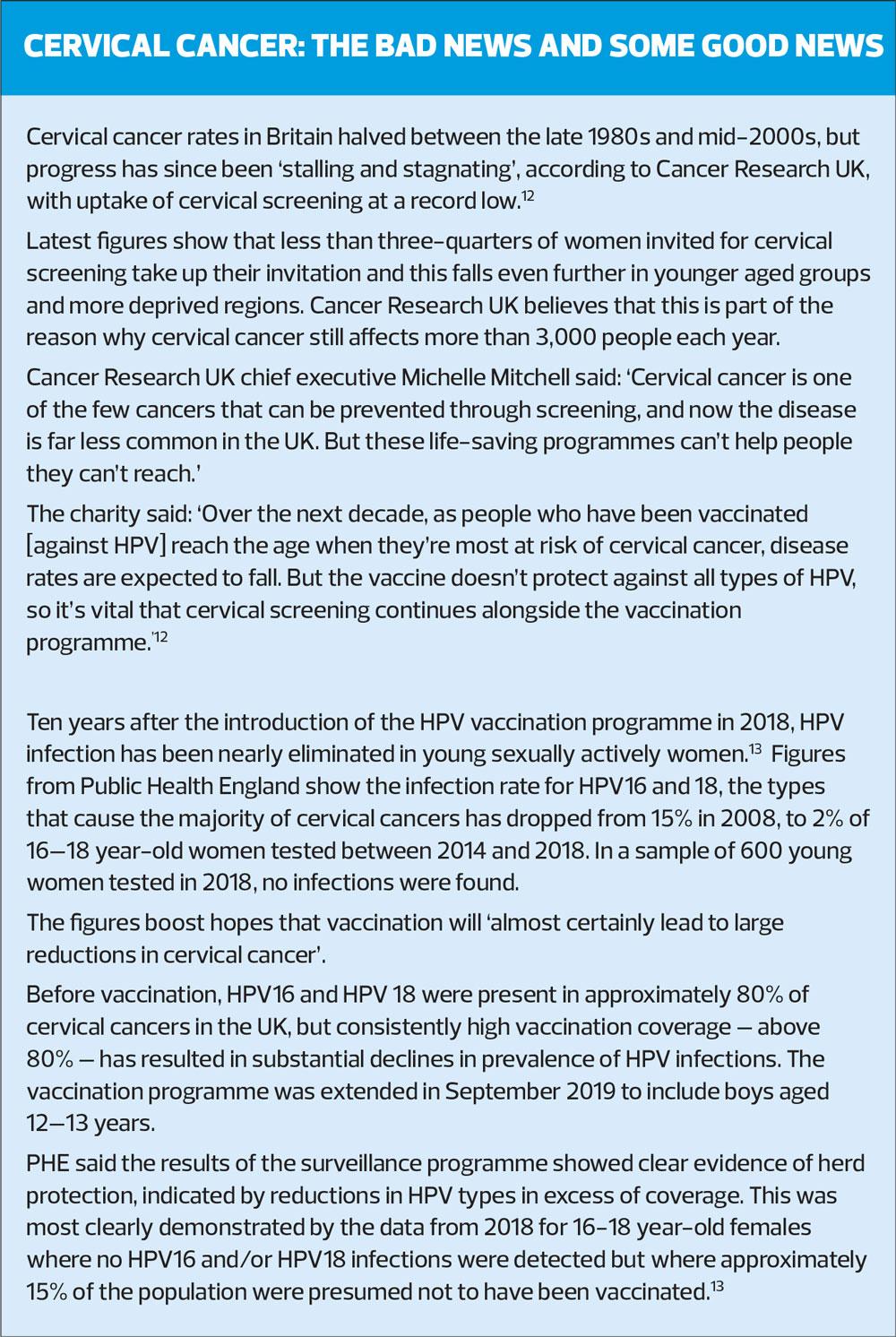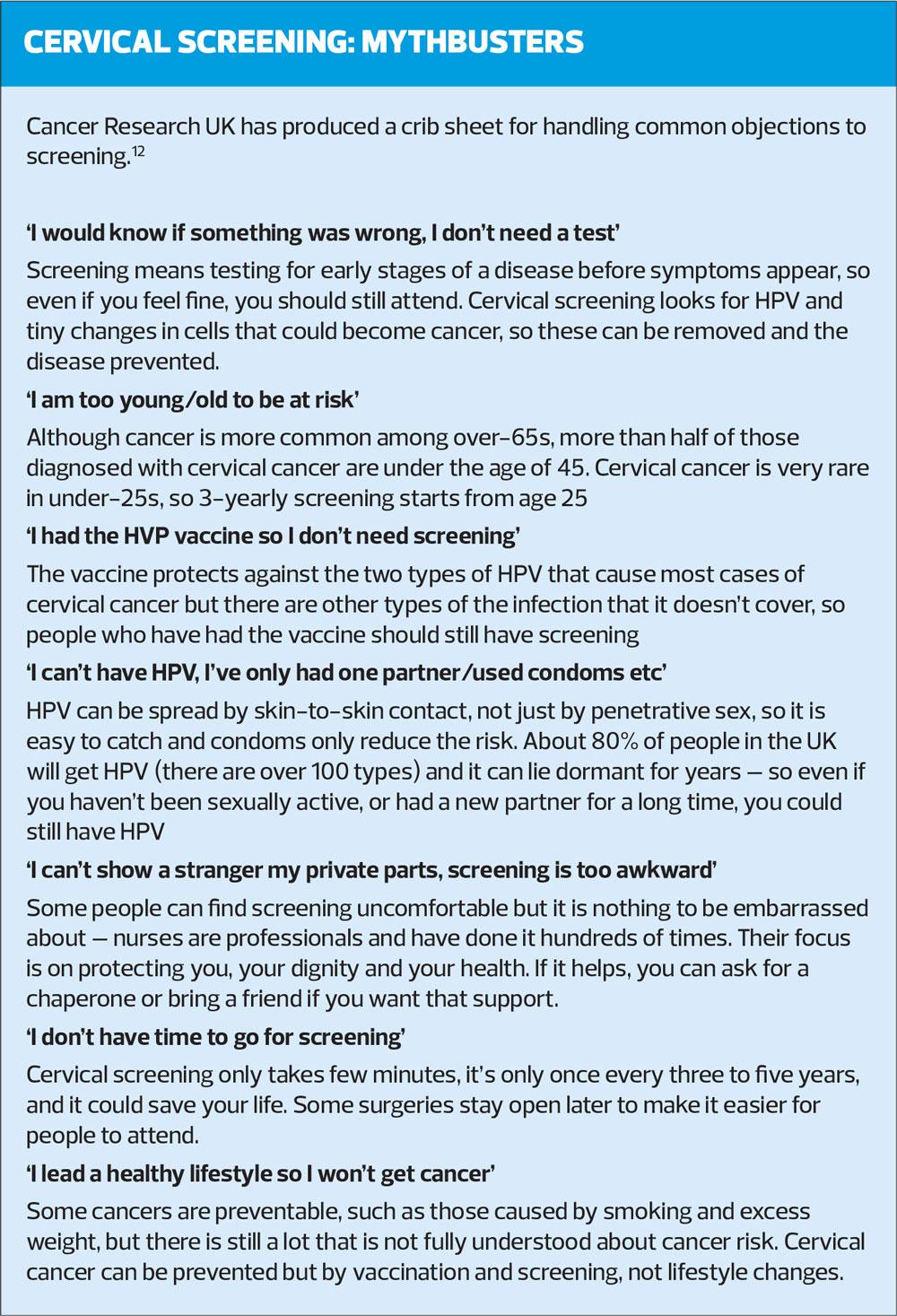Increasing cervical screening rates: misconceptions, barriers and solutions
Hazel Nelson
Hazel Nelson
EN RGN, Diploma Asthma, Diploma COPD, Diploma HCS, Critical Care QNI
Practice Nurse, Cobridge Surgery, Stoke on Trent.
Cervical cancer screening uptake is at a record low but one practice has decided to do everything possible to encourage women to attend, with dramatic results. This is how they did it.
Cervical cancer is a preventable disease that affects over half a million women and kills over 300,000 women globally.1 However, attendance rates for cervical screening in the UK are falling in all age groups, especially in the 25–35 age groups.2 In the UK there are around 3,200 new cases of cervical cancer in the UK every year; that’s around nine cases a day, and in 2017, 852 deaths.3
The aim of the NHS cervical screening programme, which has been running since the mid1980s, is to pick up the human papilloma virus (HPV), which causes over 99.9% of cervical cancers.4
All women aged between 25 and 64 are routinely invited for screening in England and Wales with intervals being determined by age. Trans men (assigned female at birth) do not receive invitations if registered as male with their GP, but are entitled to screening if they have a cervix.4 In Scotland, screening is offered 3-yearly to women (anyone with a cervix) aged 25-49 years, and 5-yearly to those aged 50-64 years.5
Cervical screening is an extremely efficient way of detecting abnormal cell changes in the cervix that potentially could develop into cervical cancer. Despite its importance, cervical screening rates have fallen over the past several years with nearly 2 million women in England currently being overdue for testing.6
A cause for concern is that the rate of cervical screening for the under-35s currently stands at 65% compared with 71% for all eligible women in England, a decline of 3% over the previous 3 years.6 Developing ways to combat the decline presents many challenges, but it can be done.
Our practice, the Cobridge Surgery in Stoke-on-Trent, has shown it is possible to buck the national trend and increase cervical screening rates by 20% in two years: our current rate is 80%.
Cobridge Surgery has a practice population of more than 5,000 patients, meaning that an extra 50 women would need to be screen to achieve a 1% increase in cervical screening uptake. The practice nursing team recognised we would need to be proactive if we were to improve the situation.
The practice population is multi-cultural, including European, British and Middle Eastern ethnicities, and has a high turnover due to migration. Simple changes can a make a difference, and the practice nurses needed to recognise that every woman has different needs and every culture holds different beliefs about the screening procedure. So the first step to improving uptake was to recognise the barriers.
IDENTIFYING BARRIERS
In multi-cultural communities, obstacles to increasing screening rates include language barriers, misconceptions about the procedure, and also religious beliefs. A recent study7 highlighted cultural beliefs as one of the main reasons for ethnic minority women not to accept screening. For example, some cultures believe that cervical cancer is due to intercourse outside of marriage and therefore, if women are faithful, cervical screening is unnecessary. There is also a belief that if a woman has no symptoms then screening is not necessary. Women of Asian ethnicity may not attend screening in case they receive a diagnosis of cervical cancer, which could be considered culturally shameful.7
Cobridge has a large Asian community so the practice has encouraged Asian women to discuss their experiences with their relatives. This has had the positive impact of mothers and daughters coming together for their cervical screening.
Another deterrent is a previous unpleasant experience of the screening process such as:
- Pain during the procedure
- Uncomfortable environment
- Not enough time allowed for the procedure, and
- Embarrassing booking process.8
Negative experiences can be a barrier to repeat attendances, so it is the nurse’s responsibility to know and understand their population, and have the skills to communicate effectively with them.2
Barriers must be addressed if the screening target rate of over 80% is to be achieved.9
COMING UP WITH SOLUTIONS
As mentioned, at 60%, our screening rate was below the national rate and significantly below the NHS target. By making small changes across the whole general practice team, we were able to increase uptake.
Making every contact count
Each day the clinical session lists would be reviewed by the practice nurse for all health care professionals to ascertain if any of the patients attending that day required a smear test. A message would be highlighted under the relevant patient’s name informing the reception team to book the patient for a test. The reception staff would ask the patient during the booking-in process if they would like to have a test and, if the patient agreed, a suitable appointment would then be made. If the patient was available, or willing to have it done that day then it would be arranged for the patient to be booked in to the nurse’s clinic at the first available opportunity that same day. This meant that the nurse’s clinic was fuller than normal and some patient’s had to wait a little longer to be seen, but no complaints were noted.
It is standard practice to send out recall letters for cervical screening. Based on the relatively new science of colour psychology, we decided that the practice would send out all screening letters on pink paper along with a copy of Jo’s Cervical Cancer Trust leaflet inside for further information. This has become standard practice with large numbers of female patients contacting the surgery stating they have ‘received a pink letter’ or ‘could I make an appointment, I received a pink letter’, taking away the embarrassment of having to ask to book in for screening at the reception desk.
We are also able to send text reminders to all patients who are due to be screened. This is a particularly useful way of engaging with younger women for whom texting is the most popular way to communicate.10 A recent survey by Jo’s Cervical Cancer Trust found that more than 70% of women aged 25 to 30 years did not attend, or purposely delayed their test, because they felt scared.2
As cervical screening cannot take place during pregnancy, we used the child’s 12-week vaccination appointment to catch up with overdue cervical screening. By offering a joint appointment, the new mum does not have to attend twice, reducing inconvenience.
The practice offers all new patients cervical screening at their new patient check appointment, if they are due one or if they have never previously had a smear test – and in an eligible age group.
We found that patients who were offered a leaflet about screening in their first language, obtainable from https://www.gov.uk/government/publications/cervical-screening-description-in-brief, are more likely to attend for their screening. They were also shown a Jo’s Cervical Cancer Trust video on screening to help combat common misconceptions and reduce anxieties. Patients who have never had a smear test are shown the equipment for the procedure, the practice nurse explains the procedure and they are shown the video before screening is performed. With some patients the test would follow straight afterwards, whereas others would use one appointment for the information and a separate one for the screening. This allows the woman to absorb the information at their own pace and become more comfortable with the process, and helping them to feel in control of the situation.
Another innovation was to introduce online booking to make making an appointment easier and more convenient. We also offer early cervical screening sessions and out of hours appointments (within reason!) so working women can attend without having to take time off work. The ethos of gearing the appointment to patients’ individual needs rather than the needs of the practice has also helped to increase screening rates.
The practice took patients’ worries and fears into consideration and created a more comfortable environment, helping them feel more relaxed.
In many countries the screening process has a softer terminology and does not sound as daunting or clinical as a ‘screening’ or ‘cervical screening’. For example, in Romania it is called a 'papanicolau', in Italy a 'striscio vaginale' and in Greece a pap test.11 Using recognised names, dependent upon the patient’s country of origin, has also increased acceptability.
Word of mouth is a powerful marketing tool so every good experience a woman has can turn in to many more women coming forward for their cervical screening.
CONCLUSION
Cervical cancer is a preventable disease but it still affects more than 3,000 women in the UK every year, and causes around 850 deaths. All health care professionals need to encourage women to have their smear tests. Simple changes such as a reminder from the reception staff, encouragement from the GP to attend appointments, and understanding by practice nurses that every woman has different needs can lead to meeting the national targets, as we have shown in Stoke on Trent.
REFERENCES
1. World Health Organization (WHO). Cervical cancer. https://www.who.int/cancerprevention/diagnosis-screening/cervical-cancer/en/
2. Jo’s Cervical Cancer Trust. Cervical cancer screening: How can we increase uptake’. Practice Nursing 2019;30(2):80-81
3. Cancer Research UK. Cervical cancer statistics. https://www.cancerresearchuk.org/health-professional/cancer-statistics/statistics-by-cancer-type/cervical-cancer
4. Public Health England. Cervical screening: programme overview. https://www.gov.uk/guidance/cervical-screening-programme-overview
5. NHS Health Scotland. The introduction of HPV testing to cervical screening in Scotland. http://www.healthscotland.scot/media/2883/hpv-faq-for-sample-takers-november2019-english.pdf?
6. NHS. Why it’s important: Cervical Screening: 2019.
https://www.nhs.uk/conditions/cervical-screening/why-its-important/
7. Narlow C, Walker J, Wardle J. Barriers to cervical cancer screening among ethnic minority women: a quantitative study’. J Fam Plan Reprod Health Care 2015;41(4), 248-254
8. Jo’s Cervical Cancer Trust. Barriers to cervical screening among 25-29 year olds; 2019. https://www.jostrust.org.uk/about-us/our-research-and-policy-work/our-research/barriers-cervical-screening-among-25-29-year-olds
9. NHS England. 2019/20 General Medical Services (GMS) contract Quality and Outcomes Framework (QOF): Guidance for GMS contract 2019/20 in England; 2019. https://www.england.nhs.uk/publication/2019-20-general-medical-services-gms-contract-quality-and-outcomes-framework-qof/
10. Ofcom. Communications Market Report; 2018. https://www.ofcom.org.uk/_data/assets/pdf__file/0022/117256/CMR-2018_narrative-report.pdf
11. The Free Dictionary. Medical Dictionary. Papanicolaou test. https://medical-dictionary.thefreedictionary.com/Papanicolaoutest
12. Cancer Research UK. Cervical cancer progress falters as screening uptake hits record lows. Press release; 22 January 2020. https://www.cancerresearchuk.org/about-us/cancer-news/press-release/2020-01-22-cervical-cancer-progress-falters-as-screening-uptake-hits-record-lows
13. Public Health England. Surveillance of type-specific HPV in sexually active young females in England, to end 2018; 22 January 2020. https://www.gov.uk/government/publications/hpv-prevalence-in-sexually-active-young-females-in-england
Related articles
View all Articles

